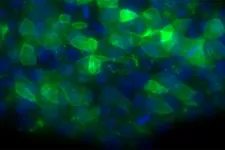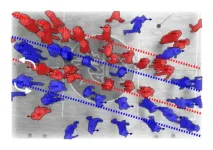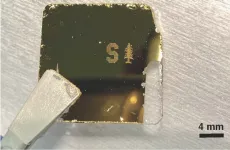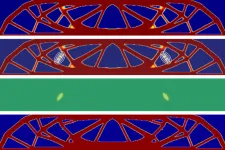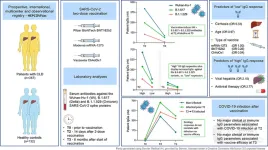(Press-News.org) Social animals should limit individuality to conform with the behaviour of the group, a University of Bristol study has found.
Scientists at Bristol’s School of Biological Sciences observed that group safety was improved when animals paid attention to the behaviours of each other.
Their findings, published today in PLoS Computational Biology, reveal that simple social behavioural rules can drive conformity behaviour in groups, eroding consistent behavioural differences shown by individual animals.
Lead author Dr Sean Rands said: “Personality suppression may be a common strategy in group-living animals, and in particular, we should tend to see the behaviours of the most adventurous or shy individuals shifting towards what the majority of the group are doing.”
The team modelled the behaviour of a small group of animals with differing tendencies while performing risky behaviours when travelling away from a safe home site towards a foraging site. They then compared this to their behaviour while completing the same activity in a group.
The group-aware individuals spent longer in the safe space and moved more quickly to the foraging spot, making the mission less dangerous.
Co-author Professor Christos Ioannou, explained: “Groups are usually made up of individuals who are different to each other in the way that they normally behave – these consistent individual differences are what determines the personality of the individual.
“Experimental evidence for this comes from animals like the stickleback fish that we study in our lab. We can measure the personality of individual fish when they are given a food-finding task on their own, and compare it to what happens when they are put in a group of mixed personalities and given the same task.
“When faced with a social task, we find that the fish tend to suppress their own behaviour, and instead conform with what other fish in the group are doing.”
Dr Rands concluded: “We find that if individuals pay attention to other group members, this has an overall impact on the efficiency of the group, and demonstrates that simple social behaviours can result in the suppression of individual personalities.
“This suggests that compromise may lie at the heart of many social behaviours across the animal kingdom.”
Paper:
‘Personality variation is eroded by simple social behaviours in collective foragers’ by Sean Rands and Christos Ioannnou in PLoS Computational Biology.
END
Animals best to supress personalities for group efficiency
2023-03-02
ELSE PRESS RELEASES FROM THIS DATE:
Possible treatment strategy identified for bone marrow failure syndrome
2023-03-02
Bone marrow is the spongy tissue inside bone responsible for making red blood cells, white blood cells and platelets. Bone marrow failure syndromes lead to an increased risk of developing dangerous infections, anemia and an increased risk of blood cancers.
Research led by Washington University School of Medicine in St. Louis has identified a possible treatment strategy for a rare bone marrow failure syndrome that is named poikiloderma with neutropenia. The work also may have implications for treating other bone marrow failure syndromes with similar underlying dysfunctions.
The research is published March 3 in the journal ...
Stick to your lane: Hidden order in chaotic crowds
2023-03-02
Have you ever wondered how pedestrians ‘know’ to fall into lanes when they are moving through a crowd, without the matter being discussed or even given conscious thought?
A new theory developed by mathematicians at the University of Bath in the UK led by Professor Tim Rogers explains this phenomenon, and is able to predict when lanes will be curved as well as straight. The theory can even describe the tilt of a wonky lane when people are in the habit of passing on one side rather than the other (for instance, in a situation where they are often reminded to ‘pass on the right’).
This mathematical ...
Crowdsourced reports can quickly identify an earthquake’s impact
2023-03-02
Within minutes, a statistical model based on a global database of public reports of ground shaking can be used to identify an earthquake as a high- or low-impact event, according to a new study published in The Seismic Record.
High-impact earthquakes, as defined by the study, are those associated with at least one destroyed building, at least 50 damaged buildings, at least two deaths, or any documented financial losses.
The researchers were able to provide impact results for 393 global earthquake events from 2021 within 10 minutes. Their model was developed using more than 1.5 million globally collected felt ...
Ocean surface tipping point could accelerate climate change
2023-03-02
The oceans help to limit global warming by soaking up carbon dioxide emissions. But scientists have discovered that intense warming in the future could lessen that ability, leading to even more severe warming.
The discovery comes from a study led by The University of Texas at Austin in which researchers analyzed a climate simulation configured to a worst-case emissions scenario and found that the oceans’ ability to soak up carbon dioxide (CO2) would peak by 2100, becoming only half as efficient at absorbing the greenhouse gas by 2300.
The decline happens because of the emergence of a surface layer of low-alkalinity water ...
DRI announces space education trainings for Nevada teachers
2023-03-02
DRI is pleased to announce “Space Education Educator Professional Development Training,” available for 80 educators. The training will be conducted in Las Vegas and Reno by four Nevada educators who were selected to attend the NASA Space Exploration Educators Conference in Houston in February. In addition to touring NASA facilities, the conference provided hands-on training in lesson plans and activities, and these educators will use the knowledge they gained to teach Nevada teachers.
“DRI is pleased to offer NASA-approved space education training to ...
Stanford researchers develop a new way to identify bacteria in fluids
2023-03-02
Shine a laser on a drop of blood, mucus, or wastewater, and the light reflecting back can be used to positively identify bacteria in the sample.
“We can find out not just that bacteria are present, but specifically which bacteria are in the sample – E. coli, Staphylococcus, Streptococcus, Salmonella, anthrax, and more,” said Jennifer Dionne, an associate professor of materials science and engineering and, by courtesy, of radiology at Stanford University. “Every microbe has its own unique optical fingerprint. It’s like the genetic and proteomic code scribbled ...
Integrating humans with AI in structural design
2023-03-02
Modern fabrication tools such as 3D printers can make structural materials in shapes that would have been difficult or impossible using conventional tools. Meanwhile, new generative design systems can take great advantage of this flexibility to create innovative designs for parts of a new building, car, or virtually any other device.
But such “black box” automated systems often fall short of producing designs that are fully optimized for their purpose, such as providing the greatest strength in proportion to weight or minimizing the amount of ...
Foundation for anesthesia education and research establishes endowed NAM fellowship
2023-03-02
CHICAGO – The Foundation for Anesthesia Education and Research (FAER) announced it has established an endowed National Academy of Medicine (NAM) fellowship to provide early-career anesthesiology scholars with the opportunity to experience and participate in committee, workshop, and roundtable activities of NAM and the National Academy of Sciences (NAS).
Offering a robust catalogue of research grants and programs for early-career anesthesiology investigators, FAER – an American Society of Anesthesiologists’ foundation – is always exploring new avenues of support for up-and-coming researchers. The NAM Fellowship Program was recognized as one such ...
Liver cirrhosis is associated with a lower immune response to COVID-19 vaccines but not with reduced vaccine efficacy
2023-03-02
Amsterdam, March 2, 2023 – The overall responsiveness of patients with chronic liver disease (CLD) to COVID-19 vaccines has been shown to be decreased in patients with cirrhosis. A new prospective study in JHEP Reports, published by Elsevier, now shows that this lower response is observed up to six months following two-dose COVID-19 mRNA vaccination, but it does not reduce vaccine efficacy.
In this prospective study, more than 350 patients with CLD were recruited in clinical centers from Austria, Belgium, Italy, Portugal, Romania, and Spain. Cirrhosis, alongside age and vaccine ...
Human norovirus GII.4 exploits unexpected entry mechanism to cause gastroenteritis
2023-03-02
Human noroviruses are the leading cause of acute gastroenteritis worldwide, a major global health problem for which there are no specific treatments or vaccines. Understanding the first phase of infection – the process the virus follows to invade cells – is a decisive step in the development of effective preventive and therapeutic strategies. A team led by researchers at Baylor College of Medicine is making strides in that direction.
The researchers report in the journal Nature Communications that the globally dominant human norovirus GII.4 strain invades gastrointestinal cells via an unexpected mechanism. The viral strategy involves interactions ...
